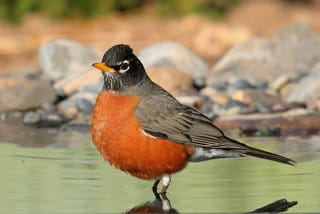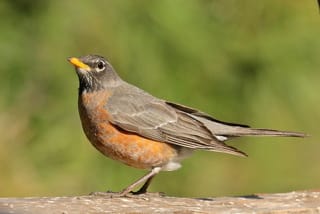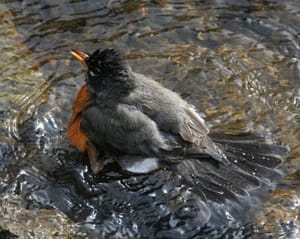Initially this guide displays common birds of all types that are flying right now in our area. Use the selectors below to view rare birds, view birds flying any time, restrict the output to a certain shape of bird, or search by name.
New Mexico is on the western edge of the Central Flyway which is one of the major migration pathways between north and south for birds traveling between breeding and wintering grounds along the Rocky Mountains. This has resulted in the state having an incredible diversity of birds with over 550 different species reported. A little more than half of this number are sighted annually on the Pajarito Plateau. Some of these birds are full-time residents, some migrate here for a few weeks or months, and other are only seen briefly as they pass through the region.
This guide features many of the birds known to frequent Los Alamos county by when they are likely to be seen in the area. You can get additional information on local birds by joining PEEC Birders or going to the eBird website. eBird also includes lists of rare bird sightings and birding hot spots.
Bird References
Birdweb
Cornell Lab of Ornithology
eBird
eNature
Institute for Bird Populations
National Audubon Society
New Mexico Ornithology Society
What Bird
xeno-canto
Subject Area Experts (all guides)
Steve Cary (butterflies)
Beth Cortright (insects)
Terry Foxx (invasive plants)
Leslie Hansen (mammals)
Richard Hansen (fish, mammals)
Dorothy Hoard (butterflies, trees)
Chick Keller (flowers, herbarium)
Shari Kelley (geology)
Kirt Kempter (geology)
Garth Tietjen (reptiles)
David Yeamans (birds)
Web Development and Content Management
Pat Bacha
Jennifer Macke
Graham Mark
Akkana Peck
Contact
Please contact us for local nature questions and sightings. We welcome comments, corrections, and additions to our guides.
For more information about local nature, please visit our Nature Blog or subscribe to PEEC This Week.
Make Selection
 Photo: male by Bob Walker  Photo: female by Bob Walker  Photo: male bathing by Hari Viswanathan |  American Robin, RobinAMRO (Turdus migratorius)Family: Turdidae (Thrushes) Size: 9 - 11 in (23 - 28 cm) Flies: Jan 01 - Dec 31 Morphology: males are gray-brown with orange underparts and dark heads; females are similar but with paler colors; both sexes have long legs and tail Status: native; common Food source: insects, spiders, berries, earthworms, and snails depending on the time of year Habitat: towns, gardens, open woodlands, coniferous forests in mountains, agricultural areas American Robin are ubiquitous in the area, particularly during summer. This species is the largest North American thrush. Robins forage on the ground, running along or hopping and then pausing when they spot prey. Males will defend nesting grounds before the arrival of females. Females build a nest made of grasses and twigs worked into a foundation of mud. Nests are usually located on a horizontal branch of a tree or shrub. The mother typically lays four “robin’s egg blue” eggs that hatch in 12 to 14 days. The young fledge about 14 to 16 days later. American Robins usually have two broods per season but may have a third. Info Photos Distribution Frequency Featured |
